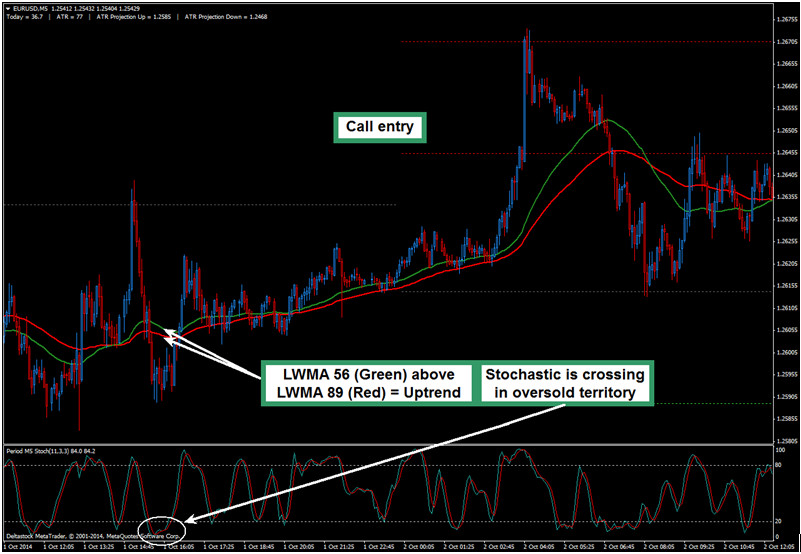The Sloth Strategy – Slow and Steady Wins the Race of the Trend
There’s been a long going “battle” between Contracts For Difference and Binary Options, with advocates for each side. Some say that binaries are easier to trade and all you need is 1 pip to win a trade, others like the flexibility of Contracts For Difference and the fact that a trade can be closed at any time. Of course, there are more differences and I am not going to outline them all here, but to satisfy both groups of people, I will give you a strategy that can be used for all types of online trading, whether it’s CFD, FX, Binary or Crypto: The Sloth Strategy.
How To Trade “The Sloth” Strategy
The strategy is fairly simple and uses just Moving Averages and a Stochastic: 56 period Linear Weighted Moving Average (LWMA), 89 period Linear Weighted Moving Average and a normal Stochastic with settings 11, 3, 3 (these indicators are available on almost all charting packages). It is nothing fancy but it works. Ok, let’s talk about how to use it: the two LWMAs will help define the trend and next we will wait for a cross of Stochastic in overbought/oversold area. When the 56 LWMA is above 89 LWMA, we are in an uptrend and we will look for Bullish trades (Buy if you are trading CFD, FX and Call if you are trading BO) which will only be taken when the Stochastic crosses in oversold, moving upwards. Reverse the rules and you get a Bearish entry. The picture will make it clearer hopefully.

There are other trades on that chart but the idea is to understand the strategy well, not to highlight every trade. Let’s go over this Bullish entry a bit: notice the Green line (LWMA 56) is above the Red line (LWMA 89); this means the trend is UP according to our strategy so we just need the Stochastic to enter the oversold area (that’s below the 20 level) and to cross, moving upwards, out of this area (that’s called a bullish cross). For a Bearish trade you need the Red line to be above the Green one and the Stochastic to reach overbought (above 80) and cross there, coming downwards (aka a bearish cross).
Entry Rules Summary
Bullish Trades
- Green line above Red line
- Stochastic 11, 3, 3 reaches oversold and a bullish cross occurs
Bearish Trades
- Red line above Green line
- Stochastic 11, 3, 3 reaches overbought and a bearish cross occurs
Trading FX, CFD, Crypto And BO With “The Sloth”
Obviously, if you will be trading Binary Options you will have to press Call/Put to open a trade and for CFD or FX, you will press Buy/Sell. The entry conditions are the same and we don’t need to delve any longer on that. However, the exit conditions are quite different: when trading BO, the trade will be closed when the expiry time is reached and you cannot do anything about it. Open the trade and wait for expiry.
When trading Contracts For Difference (on currency pairs, crypto, stocks, indices, etc.) you will have to take care of the Stop Loss and Take Profit orders. A sound Stop Loss placement is behind the previous high/low, i.e. if you open a Buy, the Stop Loss goes behind the previous low and if you open a Sell, it goes behind the previous high. As for Take Profit, you will have to gauge the condition of the market: if you are in a strong trending market, consider moving to breakeven as soon as possible and then set a Trailing Stop Loss, which means it will actively move at a set distance behind price. If the market is not in a clear trend, use a risk to reward model of at least 1:1.
Why does “The Sloth” Strategy Suck?
As everybody knows, the sloth is slow (and probably lazy) so I borrowed its name for this strategy because the Moving Averages I chose are very slow. This makes them lagging a bit and the consequence is that sometimes price starts to move in a certain direction before our lines cross. However, that is not a big problem because we want to trade an established direction, not every cross of two lines.
Why “The Sloth” doesn’t Suck?
First of all, this is a very simple strategy which doesn’t require a lot of experience and can be traded with just a basic understanding of the market. Without trying to be too harsh, I must say that if you find this strategy complicated, you should go back to studying because you are not ready to risk real money. There’s something else about it: the fact that uses 2 slow Moving Averages limits the false signals. If the lines would have been faster, they would cross a lot more often, thus giving more trades but the accuracy would drop.
Tips for Increased Accuracy
- Only trade when the slope of the 2 lines agrees with your trade direction (they need to be moving up if you want to place a Bullish trade and down if you want to place a Bearish trade).
- Only trade when the lines are spread apart, not close together
- Take into account Support and Resistance
- Only take the first signal after a cross of the 2 lines
- Monitor a wide basket of assets and only trade the ones with a good trend
Wrapping It Up – The Sloth is Your Friend…?
If you are looking for high-frequency trading, I don’t think this is the strategy for you because it won’t satisfy the need to have 20-30 trades per day. I can’t say it’s an amazing strategy that will make you rich overnight but I’ve traded with it and it performed well, especially with the help of the tips I gave above. And remember, any strategy is only as good as the trader who’s using it!